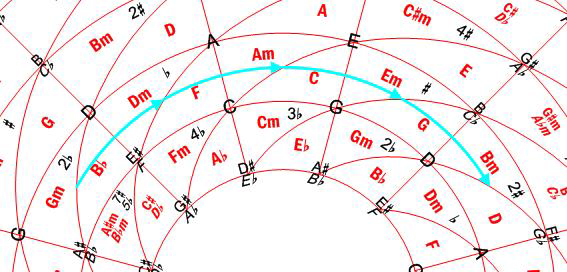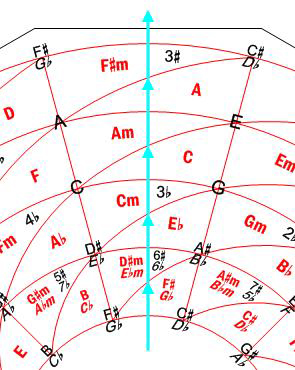|
8. MAP OF THE KEYS
The Major or minor character of a scale is named Mode. The fact that Western music has evolved to the so called Major-minor System means that most musical works or passages are composed, basically, by the notes of a certain Major or minor scale.
On the other hand, the tonic of the Major or minor scale becomes the “tonal center” and determines the Key. So, a key represents a tonic and a Major or minor mode. Thus, it is said that certain work or passage is written “in the C Major key” or “in the F minor key”. minor key”.
This way, each Major and minor scale has an associated key with the same name. The difference between the scale and the key is that, in the scale, the notes are sorted out by their pitch, while in the key the notes appear in any order and even several of them can be played at the same time.
Traditionally, the keys have been sorted out by means of the so called Cycle of Fifths. Basically, this means that, when passing from one key to another having one more sharp or one less flat, the new tonic is a P 5th above the previous one. In the Harmonic Wheel, the Cycle of Fifths in found along any circular band (Fig. 9).

Figure 9. Cycle of Fifths, along a circular band.
The cycle of fifths is also used to determine how close two given keys are. Thus, for example, two relative keys, as D Major and B minor, are very close to each other. In the same way, those keys which key signatures only differ in one accidental are also close; for example, F Major and C Major, or F Major and B Major. Major.
Nevertheless, there is a particular case of close keys that is not visible in the cycle of fifths. It is the one corresponding to the Change of Mode. It is well known that keys such as C Major and C minor, or E minor and E Major, etc., are very close to each other. It is also said that they are Parallel Keys. However, this fact is not seen in the cycle of fifths, since their key signatures differ in 3 accidentals. On the contrary, in the Harmonic Wheel the proximity between parallel keys is clearly shown, since they are one next to the other in the radial direction (Fig. 10). Moreover, because each radius begins and ends with the same note, when an end is reached, it is possible to continue from the other one, thus closing another cycle in this direction.

Figure 10. Cyclic Changes of Mode, in the radial direction.
So, while the cycle of fifths shows the keys on a line (that is, in one dimension), the Harmonic Wheel shows them on a surface (that is, in two dimensions). Therefore, the Harmonic Wheel provides a complete and panoramic view of all the existing relationships among the Keys. This is, as a matter of fact, one the most important characteristics of the Harmonic Wheel: the so called MAP OF THE KEYS.
|